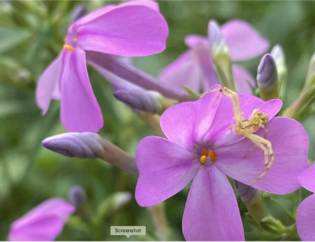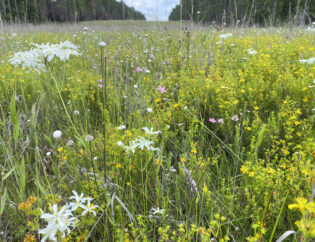
Some common names can be troublesome, especially if several different species share the same common name. How many different shrubs are called “Possum Haw?” I know of at least two, one is a viburnum and the other is a holly. But common names can also have a certain amount of charm, showcasing a plant’s cultural connection to the people who grew up with a plant integral to their daily lives. Or sometimes a common name can just be extremely descriptive, like “Sparkleberry,” for the shiny leaves of Vaccinium arborescens. Or, when you see a Catalpa tree, bedecked with long, stringy bean-like seed pods, the name Cigar Tree is easy to understand.
But “Fishbait Tree?”

That is a bizarre name, bringing up smelly visions of worms or shrimp in buckets, flies, hot, sticky, Southern summer days, and fishing. I don’t think of a grand, spreading, shade tree with heart shaped leaves, bedecked with ten-inch panicles of creamy white flowers when I think of fishbait. What, exactly what, is that name describing?
The Catalpa tree is the larval host for the Catalpa Sphinx Moth, (Ceratoma catalpa). The adult moth is rather large, it has a three-inch average wing span. It isn’t a show stopping moth, like the beauties in the Saturniid clan, the Luna moth (Actias luna) or the Io Moth (Automeris io). But it is still a handsome creature, with wings in soft shades of fawn or charcoal gray, dotted, dashed, and pinstriped in darker, complimentary, tones.
The female Catalpa Moth lays a large clutch (100 – 1,000) of tiny pale grey-green eggs on the underside of one of the fuzzy, heart shaped leaves, and within a couple of weeks, tiny pale catalpa “worms” wriggle and chew. Through their first few instars*, the caterpillars are gregarious, marching and munching across leaves in little groups.
In a few more days, the second or third instar, they become slightly larger white “worms” with bold black spots and a sprig of a black horn on their back ends. By the third week and fifth instar the catalpa worm has reached a length of 3 to 4 inches, and is munching by itself. Not every tree will have a host of caterpillars. Some trees may have caterpillars one year, and none the next. Some trees may occasionally be defoliated from this hungry insect army, but the tree quickly produces new leaves within a month’s time.

But that juicy, fat, wriggly caterpillar is where the “fishbait” comes in. Apparently, Catalpa worms make great fish bait for bream, catfish, and other finny freshwater denizens. Fisherfolk may spread a tarp under the Catalpa tree and shake it, knocking the fat, hapless, caterpillars onto the ground for fishbait. You too can bag up and store caterpillars in the freezer, saving the caterpillars for fishing forays later in the year.
Beyond fishbait, if you don’t fish, why should you have a catalpa? It is a showy, interesting shade tree that grows quickly to 40-60 feet, with large heart shaped leaves that can give your yard’s plant palette a different, interesting texture. The 2-inch-wide tubular flowers are huge, occur in large clusters, and bloom in late spring, when most other flowering trees have stopped showing off. Catalpa flowers provide good forage for native bees and hummingbirds. During the 1800’s, the Northern Catalpa was used for fence posts, as it was rot and insect resistant and the lustrous, buttery yellow wood was used for furniture and carvings.
(*In arthropods, which includes insects, an instar is the developmental stage between each moult of the exoskeleton that is shed as the arthropod grows in size and maturity. Caterpillars may have 5 instars. Wikipedia, https://en.wikipedia.org/wiki/Instar)
More reading:
https://www.wildflower.org/plants/result.php?id_plant=CABI8
https://plants.usda.gov/home/plantProfile?symbol=CABI8
https://www.butterfliesandmoths.org/species/Ceratomia-catalpae
Note: There are dozens of youtube videos on collecting, processing, and using catalpa worms for fishbait. Too many to list here.









